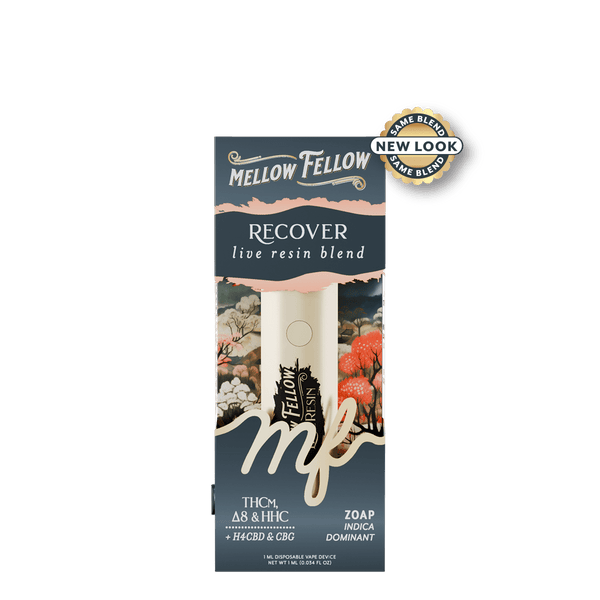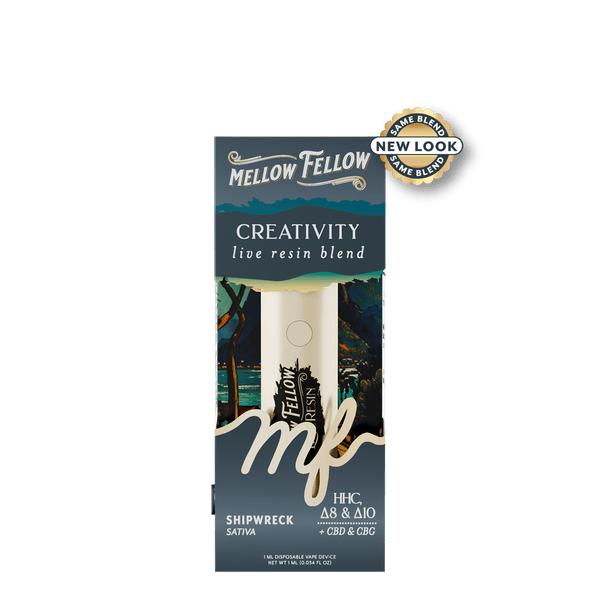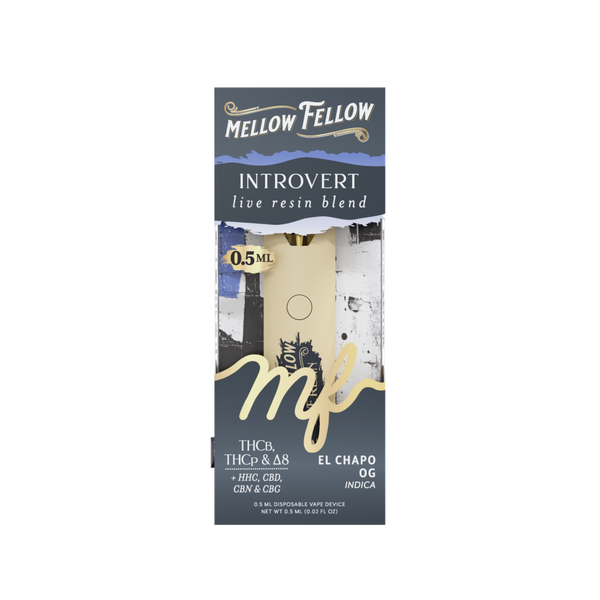Are Terpenes More Important Than THC? What Research and Users Tell Us

Quick Answer: THC determines how high you feel, but terpenes shape how that high feels - its mood, focus, and duration. Research and user reports show terpene-rich, full-spectrum cannabis delivers more balanced and satisfying effects than pure THC products.
You're probably here because you bought a high-THC product that didn't deliver - or maybe a "weak" percentage hit way harder than expected. The cannabis industry spent decades obsessing over THC numbers, creating a perception that potency equals percentage.
But experienced users and researchers now understand that terpenes - the aromatic compounds that give cannabis its smell - play a critical role in shaping your experience.
The short answer: It's not one or the other.
THC content determines psychoactivity, but terpenes help shape the mood, energy, and character of the effects. Being familiar with this relationship helps you choose products that actually match your goals instead of chasing arbitrary potency numbers.
Key Takeaways
- Terpenes influence how THC feels, guiding mood, clarity, and energy while THC drives psychoactivity.
- The entourage effect shows cannabinoids and terpenes work better together than THC alone.
- Beta-caryophyllene activates CB2 receptors, while linalool and myrcene interact with serotonin and dopamine systems.
- Live resin preserves up to 70% of terpene content, while distillates lose most aromatic compounds.
- Lab reports should list 2-4% total terpenes and identify dominant ones to predict effects accurately.
- THC-only products suit microdosing, cost efficiency, and flavor-sensitive users but feel less nuanced.
- For richer, goal-matched effects, see Mellow Fellow’s live resin vapes and terpene-targeted blends.
THC vs. Terpenes: What They Actually Do
|
Component |
Primary Function |
How You Feel It |
Onset Time |
Duration |
|
THC (Δ9-tetrahydrocannabinol) |
Activates CB1 receptors in the brain and nervous system |
Euphoria, altered perception, body effects |
5-15 min (vapes), 45-90 min (edibles) |
2-4 hours (vapes), 4-8 hours (edibles) |
|
Terpenes (aromatic compounds) |
Modulate cannabinoid activity, interact with neurotransmitter systems |
Mood direction, energy level, body sensation quality |
Immediate (aroma), 5-10 min (effects) |
1-3 hours alongside cannabinoids |
|
Entourage Effect |
Synergistic interaction between all compounds |
Enhanced, more predictable effects than isolated THC |
Varies by product format |
Full experience duration |
THC is psychoactive - it gets you high by binding to cannabinoid receptors throughout your body. But THC alone produces a relatively one-dimensional experience.
Terpenes don't directly cause intoxication in the way THC does, but research and user reports suggest they significantly influence how that intoxication feels.
Think of THC as the engine and terpenes as the steering wheel. A powerful engine without steering goes nowhere useful. That's why Mellow Fellow blends approach focuses on precise terpene profiles matched to specific experiences rather than chasing maximum THC percentages.
The Entourage Effect: Why Whole-Plant Chemistry Wins
The entourage effect explains why full-spectrum cannabis products often feel more balanced and effective than isolated THC. Research on endocannabinoid system interactions shows this phenomenon occurs when cannabinoids, terpenes, and flavonoids interact synergistically to modulate each other's effects.
Growing preclinical and some clinical research support synergy between terpenes and cannabinoids, showing that whole-plant cannabis extracts may produce enhanced outcomes compared to pure THC isolate, even when THC content is lower.This happens through several mechanisms:
Receptor Modulation: Some terpenes alter how cannabinoids bind to receptors. Research published in the Proceedings of the National Academy of Sciences demonstrates that beta-caryophyllene directly activates CB2 receptors, functioning as a dietary cannabinoid itself and potentially reducing inflammation without psychoactive effects.
Blood-Brain Barrier Permeability: Certain terpenes may increase THC's ability to cross into the brain. Studies on myrcene's potential benefits have demonstrated the ability to increase cell membrane permeability, potentially allowing more THC to reach CB1 receptors in the central nervous system.
Neurotransmitter Activity: Terpenes interact with serotonin, dopamine, and GABA systems independent of cannabinoid receptors. Research on linalool's anxiolytic effects shows this terpene modulates serotonin and dopamine activity in behavioral models, which may counteract THC-induced anxiety in some users.
This is why our live resin collection preserves the full plant profile - flash-freezing fresh cannabis immediately after harvest locks in volatile terpenes that would otherwise degrade during traditional drying and curing.
Common Terpenes and Their Effects
|
Terpene Name |
Aroma Profile |
Reported Effects |
Found In (Strains) |
Boiling Point (°F) |
|
Myrcene |
Earthy, musky, herbal |
Sedating, muscle relaxant (animal studies, user reports) |
Blue Dream, Granddaddy Purple, OG Kush |
334°F |
|
Limonene |
Citrus, lemon, orange |
Mood elevation, stress relief (behavioral models) |
Sour Diesel, Super Lemon Haze, Green Crack |
349°F |
|
Pinene |
Pine, forest, sharp |
Alertness, memory retention (preclinical data) |
Jack Herer, Blue Dream, Strawberry Cough |
311°F |
|
Linalool |
Floral, lavender, spicy |
Calming, anxiety reduction (small trials, user reports) |
Lavender Kush, LA Confidential, Master Kush |
388°F |
|
Caryophyllene |
Pepper, spicy, woody |
Anti-inflammatory, pain relief (CB2 activation) |
GSC (Girl Scout Cookies), Gelato, Chem Dawg |
266°F |
|
Humulene |
Earthy, woody, hoppy |
Appetite suppression (animal studies) |
Sour Diesel, White Widow, Headband |
388°F |
|
Terpinolene |
Floral, herbal, citrus |
Uplifting, clear-headed (user reports) |
Jack Herer, Dutch Treat, XJ-13 |
366°F |
Notice the boiling points - this matters for vaping. Terpene loss can occur even below the boiling point through volatilization. To preserve delicate terpenes like pinene and caryophyllene, start vaping at lower temperatures (around 315-350°F) and only increase as needed.
This is why we recommend starting at lower temperatures with terpene-rich products like our Creativity Blend Blue Dream Disposable, which preserves pinene and limonene for focus-enhancing effects.
These effects are best-established in animal studies, small trials, and consumer reports, but individual responses may vary. Our complete list of cannabis terpenes and their effects provides deeper detail on how each compound interacts with your body's systems.
How to Read Terpene Lab Results (COAs)
Certificate of Analysis (COA) documents show exactly what's in your product - including terpene breakdowns most buyers ignore. Here's how to use them:
Look for Total Terpene Percentage: Quality products list 2-4% total terpenes. Anything under 1% suggests degraded material or harsh extraction methods. Our testing page shows how we maintain 2.5-3.8% terpene content across live resin products.
Identify the Dominant Three: The top three terpenes by percentage determine most of the character. If you see:
- Myrcene + Linalool + Caryophyllene = expect sedation
- Limonene + Pinene + Terpinolene = expect energy and focus
- Balanced mix with no single dominant terpene = expect versatile, moderate effects
Check for Missing Terpenes: Some COAs only test for cannabinoids and skip terpenes entirely. This usually means the product has minimal terpene content worth reporting - a red flag for distillate or older material.
Verify Batch-Specific Results: Reputable brands provide QR codes linking to the specific batch you're holding. Generic COAs or lab results from months ago don't tell you what's actually in your current product. All Mellow Fellow products carry batch-specific QR codes that pull live COA data.
When THC Matters More Than Terpenes
Despite terpenes' importance, some situations call for high-THC products with minimal other compounds:
Microdosing for Tolerance Breaks: Pure THC allows precise dose control when reducing tolerance. Small amounts (2-5mg) provide baseline effects without additional terpene complexity that might trigger cravings.
Medical Symptom Relief: Some conditions respond specifically to THC's CB1 activation - nausea reduction, appetite stimulation, certain pain types. In these cases, isolated THC or high-ratio products work better than full-spectrum options.
Cost Per Milligram Efficiency: High-THC distillate offers the most cannabinoid content per dollar. If budget is the primary concern and effects are secondary, 90% THC carts provide the most economical milligrams.
Flavor Sensitivity: Some users dislike terpene taste or experience irritation from aromatic compounds. Pure distillate with food-grade flavoring provides THC effects without plant terpenes.
However, most recreational and many medical users find terpene-rich products like our Tranquility Blend Master Kush Vape deliver more satisfying results despite "lower" THC percentages because the effects feel more complete and balanced.
When Terpenes Matter More Than THC
Often, terpenes matter more than the THC content itself - let’s take a look.
First-Time or Sensitive Users: Terpenes allow you to customize the experience independent of THC intensity. A 10mg THC edible with calming linalool feels completely different from 10mg with energizing limonene - same THC dose, opposite character.
Avoiding Anxiety or Paranoia: Limonene and linalool show anxiolytic effects in behavioral studies and may help counteract THC-induced anxiety. Products with these terpenes at 1.5%+ may help anxious users enjoy THC without negative mental effects. Our guide to edibles for anxiety explains how terpene selection matters more than potency for anxiety-prone individuals.
Functional Daytime Use: Terpene profiles help determine whether you can work, socialize, or exercise after consumption. Pinene-rich products may support mental clarity, while myrcene-heavy options tend toward relaxation regardless of THC percentage. Check out our best sativa strains for focus to see how terpene profiles support productivity.
Flavor and Aroma Preferences: If you vape primarily for taste, terpene content matters infinitely more than THC. Live resin and full-spectrum products deliver complex, plant-accurate flavor that distillate can't match. Our live resin disposables showcase how proper terpene preservation creates dessert-like flavor without artificial additives.
Entourage Effect Maximization: Preclinical research and a growing number of clinical observations suggest the entourage effect may enhance results, though further human studies are needed.
Whole-plant extracts with intact terpene profiles show promise for enhanced therapeutic effects compared to isolated cannabinoids. Understanding the entourage effect helps explain why full-spectrum products often outperform isolated compounds.
Terpene Preservation Across Product Formats
Different consumption methods affect terpene content

Live Resin Vapes (Best Preservation): Flash-frozen material generally preserves the majority, often 50-70%, of the original terpene content. Low-temperature extraction keeps volatile compounds intact. Our live resin vape cartridges maintain full aroma profiles because we never let material oxidize or heat-degrade before extraction. Learn more about what makes live resin special in our detailed guide.
Cured Resin and Distillate Vapes (Moderate Loss): Traditional drying removes 40-60% of terpenes before extraction. Distillation strips most remaining terpenes, which are then reintroduced as botanical or cannabis-derived terps. This works for standardization but loses subtle plant chemistry. Our comparison of live resin vs distillate carts breaks down these differences.
Edibles (High Loss, But Doesn't Matter): Baking and digestion destroy most ingested terpenes. However, some terpenes convert to other active compounds during metabolism. Edible effects come primarily from THC conversion to 11-hydroxy-THC in the liver, not terpene preservation.
Flower (Variable, Depends on Cure): Well-cured flower retains 50-70% of peak terpene content if stored properly (sealed, dark, cool). Dry or old flower loses terpenes rapidly - that "hay smell" is terpene degradation. Pre-rolls lose terpenes faster than whole buds due to increased surface area.
For maximum terpene benefits, vaporization of live resin or properly-stored flower wins. This is why users report our disposable vapes deliver fuller flavor and more predictable effects than traditional carts - the extraction process preserves what matters.
Practical Product Selection Based on Your Goal
Use this framework instead of just checking THC percentages:
Morning Energy and Focus
- Look for: Limonene + Pinene + low Myrcene
- THC: 60-75% works well; higher isn't necessarily better
- Format: Vape for fast onset and easy redosing
- Example: Sativa-dominant live resin with citrus aroma
Afternoon Productivity
- Look for: Terpinolene + Caryophyllene + Pinene
- THC: 50-70% to avoid sedation
- Format: Vape or low-dose edible (5-10mg)
- Example: Hybrid blends with balanced profiles
Evening Wind-Down
- Look for: Myrcene + Linalool + Caryophyllene
- THC: Any percentage works; terpenes do heavy lifting
- Format: Edibles for longer duration, vapes for faster onset
- Example: Our Tranquility Blend with indica-dominant terpenes
Creative Work
- Look for: Limonene + Pinene + Terpinolene
- THC: 60-80%; too high may cause distraction
- Format: Vape for easy dose control
- Example: Creativity Blend Shipwreck Vape with preserved terpene complexity
Social Situations
- Look for: Limonene + low Myrcene + moderate THC
- THC: 40-60% to stay conversational
- Format: Low-dose edibles or moderate vape puffs
- Example: Balanced hybrid with uplifting terpene profile
Sleep Support
- Look for: High Myrcene (2%+) + Linalool + Caryophyllene
- THC: 70-85% plus terpenes
- Format: Edible for sustained effects, or vape 30-60 min before bed
- Example: Indica-dominant live resin with sedating terpene combo like our Papaya Peach Terp Sauce Vape
 Notice how THC percentage becomes secondary once you know your terpene targets. Many users find that a 65% THC product with well-matched terpenes provides better results than 90% THC with degraded profiles for every goal except raw potency.
Notice how THC percentage becomes secondary once you know your terpene targets. Many users find that a 65% THC product with well-matched terpenes provides better results than 90% THC with degraded profiles for every goal except raw potency.
Browse Delta-9 edibles if you prefer longer-lasting effects without frequent redosing.
Terpenes and THC: Final Thoughts
THC may be the star of cannabis, but terpenes direct the entire experience. From mood and focus to relaxation and creativity, these aromatic compounds determine the character of each strain.
Studies on beta-caryophyllene, linalool, and myrcene show how terpenes interact with receptors and neurotransmitters to enhance or fine-tune THC’s impact. When combined, they form the entourage effect - an intricate synergy that pure THC can’t replicate.
Understanding terpene profiles and COAs helps you choose products that match your goals instead of chasing high percentages. For a complete, flavorful experience, Mellow Fellow’s live resin vapes and effect-based blends preserve the full plant chemistry that makes cannabis truly special.
Frequently Asked Questions
How Do Terpenes Affect THC Absorption in the Brain?
Certain terpenes, such as myrcene, can increase cell membrane permeability, allowing THC to cross the blood-brain barrier more efficiently. This can intensify or alter how quickly effects appear, influencing the perceived potency even if THC levels remain the same.
Why Do Two Products With the Same THC Percentage Feel Different?
Terpene profiles dramatically change how THC feels. A 20% THC product rich in limonene may feel uplifting, while one dominated by myrcene could feel sedating. This is why identical THC percentages often produce completely different experiences.
Can Terpenes Reduce THC-Induced Anxiety?
Yes. Linalool and limonene have shown anxiolytic properties in studies and user reports. When paired with THC, these terpenes can balance the experience, reducing overstimulation and creating a calmer, smoother high.
Do Terpenes Have Benefits Without THC?
Many terpenes interact with neurotransmitters independently. For example, beta-caryophyllene can activate CB2 receptors linked to inflammation regulation, and pinene may support alertness. Even without THC, terpene-rich hemp products can produce noticeable effects.
How Can I Tell if My Vape or Edible Still Contains Terpenes?
Check the Certificate of Analysis (COA) for a “Total Terpenes” percentage. Quality products maintain 2-4%. If the report only lists cannabinoids, it likely contains little or no terpene content due to degradation or overprocessing.
Are Live Resin and Full-Spectrum the Same Thing?
Not exactly. Live resin refers to extracts made from flash-frozen plants that retain more terpenes, while full-spectrum refers to any extract that preserves the full range of cannabinoids and terpenes. Live resin is typically one of the richest full-spectrum formats available.
Sources
- Linalool as a Therapeutic and Medicinal Tool in Depression Treatment: A Review - PMC
- Myrcene—What Are the Potential Health Benefits of This Flavouring and Aroma Agent? - PMC
- Beta-caryophyllene is a dietary cannabinoid | PNAS
- The Endocannabinoid System, Cannabinoids, and Pain - PMC
Share on Social
















Leave a comment